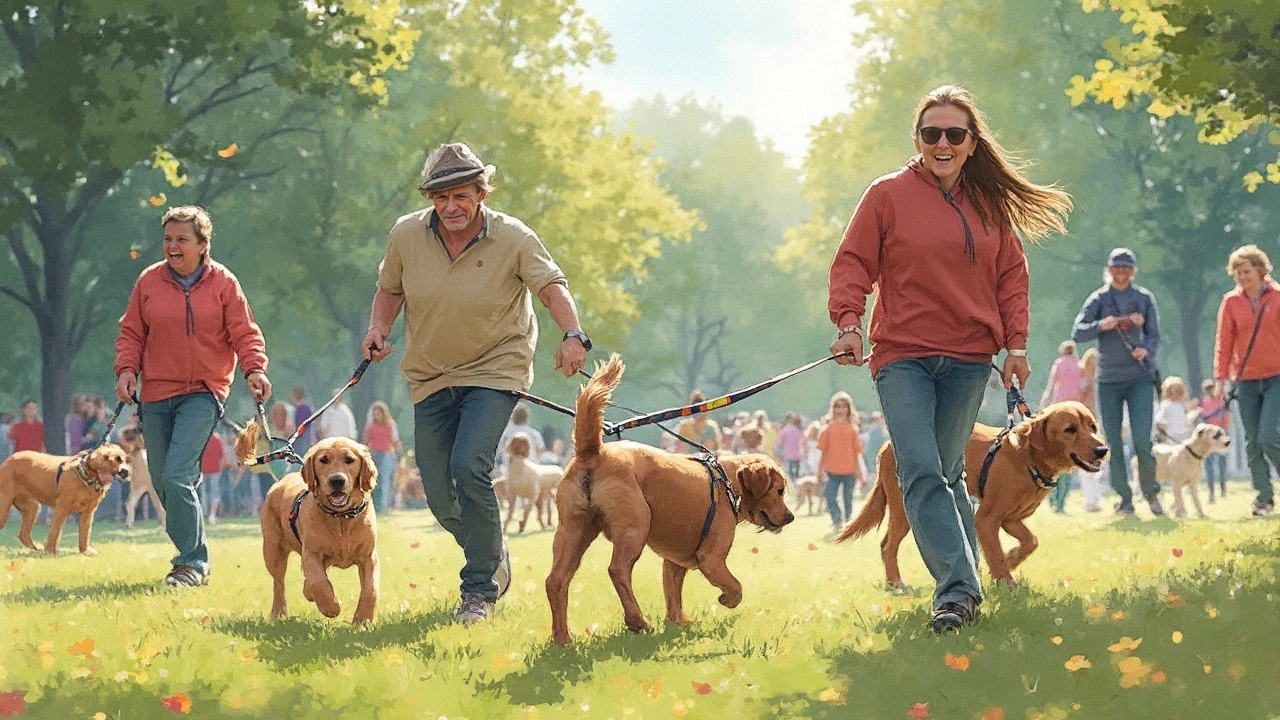Thinking about a shock collar for your dog? Before making that decision, consider some humane alternatives. Why stress your furry friend when there are other surprisingly effective ways to train them?
Let's unpack why shock collars might not be the best choice. They can cause physical pain and emotional stress to our beloved pets. Who wants that? It's like trying to learn under pressure, and who can do that well?
Now, about those alternatives. You can start with positive reinforcement—a fancy term for giving treats or praise when your dog behaves! It's a game-changer and works wonders. Or what about clicker training? It's like a special language between you and your pet, building trust step by step.
- Introduction to Shock Collars
- The Case Against Shock Collars
- Humane Training Tools
- Positive Reinforcement Strategies
- Success Stories and Practical Tips
Introduction to Shock Collars
Let's talk about shock collars. They're one of those controversial training tools that spark debates among dog lovers. Basically, a shock collar is an electronic gadget you strap on your dog's neck. When the dog does something not so great, it delivers a small electric shock. Sounds harsh, right?
The idea is to discourage unwanted behaviors like barking, digging, or even jumping all over your guests. But here's the catch—a lot of folks argue that it leans more on fear rather than education. The question we need to ask is whether it's humane, and if it's the most effective way to teach Rover good manners.
How Do Shock Collars Work?
Most shock collars come with different levels of intensity. You can often control them with a remote, which means you have to be on the ball to correct behaviors instantly. Some collars even come with other features like vibration or a beep before the shock, giving your dog a warning signal.
Most dogs eventually learn to associate certain behaviors with the uncomfortable shock. But can you blame them for not trusting you entirely after that? After all, we're trying to build a relationship with our pets, not fray it.
Why Are Shock Collars Controversial?
So, why all the bad rep? Several studies—like one done by PETA—show that shock collars can increase stress levels in dogs, leading to aggressive behaviors or outright fear. Not exactly what we're aiming for when we say 'good dog,' right?
Another key point is that not every dog reacts the same way. Factors like breed, temperament, and prior experiences can affect how a dog responds to a shock collar. We're not just training machines; we're talking about living, breathing homies with a lot of quirks and personality!
The Case Against Shock Collars
Let's get straight to it—shock collars are a controversial tool among dog trainers. Originally designed to curb unwanted behavior, they deliver an electric shock when a dog doesn’t follow orders. Sounds harsh, right?
Physical and Emotional Impact
Picture this: you're trying to figure out what someone wants, and you suddenly get zapped when you don't get it right. If it sounds distressing, imagine how your dog feels. It is widely known that dog collars causing pain can lead to anxiety and fear in dogs.
Studies have shown that dogs subjected to such negative reinforcement can become aggressive not just to the stimulus but to situations and people associated with it. Many dogs start expecting the shock and may become nervous, leading to even more behavioral issues. For dogs, understanding what’s expected can be confusing without any clear cues. Pain-based methods suggest obedience rather than genuine learning.
Alternative Solutions
There's a silver lining though! The rise in humane alternatives means we can now address behavioral issues without resorting to drastic measures. Tools like no-pull harnesses, which offer a gentler way to guide your pet, are becoming popular. Also, focusing on positive reinforcement instead of fear can help in fostering a trust-based relationship.
Regulatory Changes
Did you know? Some countries have outright banned the use of shock collars. Places like the Netherlands and Denmark have placed strict regulations, reflecting a growing trend towards animal welfare. The idea is simple: if we wouldn’t treat humans this way, why treat animals so?
Ultimately, the goal is for our pets to feel safe and secure while learning. There’s no need for harsh penalties when patience and positive reinforcement can do the trick. It might take time, but building that trust is priceless.

Humane Training Tools
When it comes to training our furry buddies, humane alternatives offer smarter and kinder ways. So, ditch the thought of a shock collar and look into some exciting options. These tools can help your dog learn and thrive in a positive environment.
Positive Reinforcement Collars
These collars give gentle guidance without causing discomfort. They remind dogs with soft vibrations or sounds instead of shocks. They're a neat way to communicate 'good dog' moments.
No-Pull Harnesses
These are lifesavers during walks. They distribute pressure evenly across a dog's chest instead of their neck, helping you control pulling without harm. They're ideal for energetic dogs who can't contain their excitement on walks!
Clicker Training
Ever tried clicker training? It's pretty much magic! A clicker is a small device that makes a sound when pressed. You pair the sound with a treat, and soon your dog learns to associate the click with a reward. It's like building a special 'yes!' button for your pet.
Here's how you can start with clicker training:
- Get a clicker and some of your dog's favorite treats.
- Click the device and immediately give a treat. Repeat this about 10 times.
- Use the click when your dog follows a command, then offer a treat.
- Practice regularly, and remember to keep it fun!
Table: Comparison of Humane Tools
| Tool | Purpose | Benefit |
|---|---|---|
| Positive Reinforcement Collar | Gentle Guidance | No Pain |
| No-Pull Harness | Walk Assistance | Prevents Pulling |
| Clicker | Training Signals | Boosts Comprehension |
With these humane training tools, not only does your dog learn better, but you also strengthen your bond. Training becomes a team game rather than a battle of wills. Keep it fun, light, and positive!
Positive Reinforcement Strategies
Let's talk about why positive reinforcement is making waves in the dog training scene. Instead of defaulting to negative techniques like shock collars, why not reward your dog for doing things right?
At its core, positive reinforcement is simple: reward the behavior you want to see repeated. It’s like giving a kid candy for doing their homework, but way healthier for their psyche and yours! When our dogs perform a desired action, offering a treat or a bit of praise can go a long way.
Understanding the Basics
Here's how to get started with positive reinforcement:
- Start small. Begin with basic commands like “sit” or “stay.” As soon as your dog performs the action, give them a treat or a kind word.
- Consistent cues. Use the same word or gesture every time. Consistency helps your dog make connections.
- Immediate rewards. Offer a reward as soon as the correct behavior happens. Dogs live in the now!
Making a Habit Stick
Repetition reinforces behaviors. Practicing regularly cements what your dog has learned. Don’t worry if they don’t get it right every time at first—it’s about patience and persistence.
Additionally, to keep things exciting, mix up the rewards. Use treats, playtime, or verbal praise. Some dogs work best for a game of fetch, while others are food-motivated. Know what makes your dog tick!
Troubleshooting
Sometimes, you might hit a snag. If your dog isn’t responding, check if the rewards are motivating enough. Try different treats or balance training sessions with breaks to avoid overwhelming them. Remember, a tired or stressed dog may not learn as effectively.
In fact, according to research, dogs trained with positive methods are less likely to show aggressive behaviors. So toss that shock collar and embrace the power of positivity!

Success Stories and Practical Tips
When it comes to saying goodbye to the shock collar and embracing humane dog training methods, many dog owners have amazing stories to share. These success stories are great proof of how well these alternatives work.
Real-Life Success: Meet Max
Take Max, for instance, a lively Labrador who used to pull on the leash with every walk. His owner ditched the shock collar and switched to a no-pull harness. With some patience and consistent training, Max learned to walk calmly beside his owner. This wasn't just good news for Max's owner, but also improved Max's walks significantly, making them more enjoyable and stress-free.
From Chaos to Calm: Lucy's Transformation
Then there's Lucy, a rescue dog with anxiety issues. Her owners opted out of using harsh training tools and instead, used positive reinforcement. They rewarded Lucy with treats for staying calm in stressful situations. Over time, Lucy's confidence grew, reinforcing the bond with her owners.
Practical Tips for Success
- Start Small: Implement training in small increments. Trying to teach too much at once can be overwhelming for both you and your dog.
- Be Consistent: Consistency is key in training any dog. Use the same commands and rewards to avoid confusing your pup.
- Understand Triggers: If your dog reacts badly in certain situations, recognize these triggers and prepare to manage them with patience.
- Be Patient: Dogs learn at their own pace, and getting frustrated won't help. Patience and understanding go a long way.
Extra Insight: Reinforcement and Engagement
The Ohio State University researched positive reinforcement methods and found them 30% more effective than aversive techniques, leading to a higher success rate. This aligns with many pet owners' experiences, corroborating how humane alternatives foster a better learning environment for dogs.
Remember that nurturing a good relationship with your dog through ethical training isn't just possible—it's proven to work. These stories and tips show how we can successfully switch from shock collars to kinder methods, achieving happy, obedient pets without compromising their well-being.
